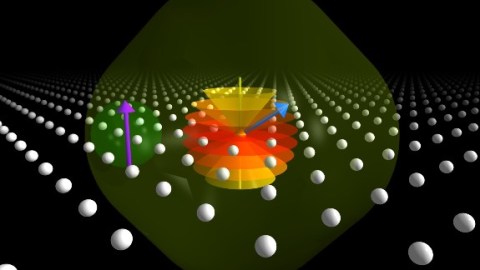From Bits to Atoms: Co-Creating the Third Industrial Revolution

New York, 1964. The World’s Fair is in full gear, as 50 million people make the trek to Queens to see what the future has in store. The exposition showcases an epic collection of consumer products, from pens to refrigerators and cars – the attendees are flooded with things to keep them busy. One of the stranger products hails from a small Italian manufacturer named Olivetti. Called Programma 101, the small team’s invention was a major breakthrough in the making. General Electric bought the device soon after its debut, and today that simple technology is widely recognized as the first ever commercial desktop computer. It wasn’t for another 3 years until Hewlett Packard’s model 9100A joined the fun, but lucrative things often have modest beginnings.
In the 50 years since, the industry has experienced a boom unlike anything since the first Industrial Revolution. A bulky box formerly stored away in research labs is now a handheld device kept in billions of pockets worldwide. This explosion of computing is in part thanks to the evolution of its hardware, but it’s been the increasingly sophisticated software, which Marc Andreeson says is in the process of eating the world, that has manifested the digital realm we now depend on.
While this innovation is undeniable, so far it’s predominantly transpired in the land of 1s and 0s. We see some residual effects and upgrades within the physical realm, but generally speaking, the world around us doesn’t look much different than it did before the computer revolution.
Peter Thiel finds this frustrating. The slogan at his firm, “We wanted flying cars, instead we got 140 characters,” speaks to this notion that things outside the localized space of the computer industry aren’t moving as fast as many thought they would. Economist Tyler Cowen wrote a book on the subject, proclaiming it The Great Stagnation. But could it be so? Have our smartphones and tablets distracted us from the hard truth that maybe we’re not much better off than we were half a century ago? Or could we actually just be nearing the cusp of the next Industrial Revolution?
It seems the latter, as the innovation within the digital world of “bits” is beginning to spill over into the physical world of “atoms”. Thanks to the global reach of the web and the rapidly decreasing price of technology, a new economy founded through bottom-up DIY innovation is on the rise. State of the art designs, customization capabilities, and modernized tools will be ushered in, as the third Industrial Revolution will be both personalized and co-created.
The early vestiges of this new economy are seen on crowdfunding platforms like Kickstarter and Indiegogo. These websites allow entrepreneurs to streamline the business of bringing a product to market, where – given there’s sufficient demand – customer’s orders function as the actual capital used to build the idea. With a prototype and solid pitch, a hobbyist playing around in his or her garage can start selling to thousands of eager customers without incurring any upfront cost. A case in point: Pebble Smartwatch, which earlier this year raised over $10 million with a plastic model and a 3 minute video explaining the product’s features. The team at Pebble consisted of CEO Eric Migicovsky and a couple of interns, but together they outsourced the manufacturing of 80,000 watches and counting. It’s a resource that gives people around the world tools to mass-distribute things of their wildest imagination, and what we’ve seen so far is just the tip of the iceberg.
If crowdfunding is the yin to the hardware revolution, crowdsourcing is its yang. In the same way software design is more robust when it’s a collaborative API, hardware experiences similar benefits when it’s the product of a global mind meld. As Sun Microsystem co-founder Bill Joy remarked, “no matter who you are, most of the smartest people work for someone else.” These dynamics are entrenched in the growing community at Local Motors, where 30,000+ car lovers collectively design, engineer and build proprietary automobiles from the ground up. Founder and CEO Jay Rogers calls the process “co-creation,” and the concept is erasing the line between company and customer. A model that was made famous through crowdsourced t-shirts on Threadless is now building vehicles of every shape, size, andfunctionality. As more and more minds around the world begin to log in to the Internet, the prospects of what can be created by the crowd is subject to nothing but the (collective) human imagination.
With the convergence of crowdfunding and crowdsourcing, alongside the rise of 3D Printing, manufacturing is approaching a whole new epoch and industries across the board are primed for disruption. The computer revolution democratized media and communications; the upcoming manufacturing revolution could democratize the rest. The hardware behind all of these technologies continues to increase exponentially in price and performance, further fortifying the capabilities of its software. Individual entrepreneurs are empowered to compete with super corporations, as “co-creation” becomes the new assembly line.
This phenomenon is widespread, as not only are communities collaborating – but different platforms and technologies are fusing together to “create” like it’s never been done before. This syndication is highlighted by Autodesk’s free app 123D Catch. It allows you to take a picture of a physical object and, with the click of a button, have it uploaded to the cloud for sharing, customizing and manufacturing at your local (or personal) 3D Printer.
Whatever we design in bits we can print in atoms (i.e. material of our choice). It’s a mind blowing concept that 10 years ago was science fiction, but in this upcoming decade these technologies will become modus operandi. How we think about the physical world and the things that comprise it will never be the same. And it’s not just limited to material products. With 3D Bio-Printers, we can manufacture anything from in vitro meat to a human heart. As this technology experiences the same accelerating growth as computers – alongside computers, which continue to abide by Moore’s Law – the breadth of what these tools can produce is limitless. From drugs that are predisposed to your genetic sequence to the buildings we live in, manipulating bits of software can transform the atoms of hardware. We’ve even begun the process of manufacturing on the atomic level. Known as nanotechnology, the precise layering of particles in the quantum-realm allows for the building of new materials and devices so powerful that physicists say the applications could include an elevator ride to the moon and solar cells capable of meeting the entire world’s energy needs.
It’s a profound shift, as the seeds planted by the original Programma 101 and the software boom that’s created our digital world sprout and flourish in the physical world. Just like any new technology, the application is at first cumbersome and impractical, but soon becomes frictionless and ubiquitous. The levels of innovation behind the Twitterverse and its digital compadres will erupt in a tangential fashion within the world of things. If today we’re seeing the earliest stages – the Programma 101’s of the 21st century – what will be the Homebrew Computer Club, the Microsofts, Apples, and Googles of the next decades? Or will there even be new, large players? Crowdfunding and crowdsourcing make each one of us part of a new type of company, created and funded by people who are simultaneously consumers and producers. These innovations in how we create supply and discover demand are changing the economic landscape, and all together, the process of co-creation is designing the third industrial revolution.





